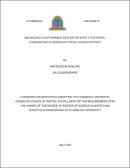Enhancing a sustainable safe water supply for rural communities of Mabungo parish, Kisoro district
Abstract
Access to safe water is still a challenge in Africa, the biggest population that suffers the challenge being from sub-Saharan African countries where Uganda is part. The major cause of limited water access is that 85% of water supply systems stop supplying water after a short while from time of implementation. The situation escalates the water crisis forcing people to use raw water from the available water bodies. This involves trekking very long distances coupled with the risk of acquiring water-borne diseases. This study focused on Mabungo parish, in Kisoro district, and investigated the factors that influence sustainable supply of water systems in the area. Data was collected from 269 respondents within Kisoro district using questionnaires. The sustainability of the potential scheme in the Mabungo parish was also tested using the participatory research method, which came up with a community based model for sustainable water supply for the communities.
The results confirmed Kabiranyuma scheme to have potential for supplying Mabungo communities with safe water to the required level of sustainability.
Adopting a participatory approach among communities of Mabungo, has high opportunities of contributing towards achievement of sustainable development goal 6, which aims at ensuring universal access to clean water and sanitation by 2030. The approach prepares rural communities to manage their water supply systems themselves during and after implementation. Though full involvement of communities in operating and managing a water supply is the main way to ensure proper functionality and sustainability, It is important to note that, support from Local Government, the responsible Ministry or external entities in form of finance, technical back stopping, operational infrastructure, regular supervision, among others can do a great deal in boosting their performance. Communities were encouraged to practice rain water harvesting to be used as a supplementary water supply in the study area.

